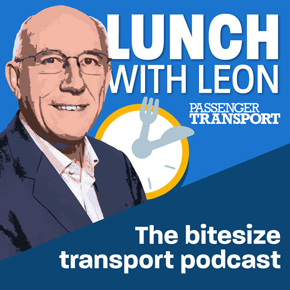Transport for London innovation director Thomas Ableman says a willingness to try and fail is the secret to success when it comes to innovation

By Robert Jack
Thomas Ableman has devoted his career to innovation within the realm of public transport, with National Express, Chiltern Railways, his own start-up and now Transport for London. And last month he gave a presentation on the subject as part of the latest series of BRTuk Lunchtime Masterclasses. Ableman, who joined TfL as director of innovation last year, offered insights on how an innovative culture can be fostered in large and small organisations.
Policy-led innovation
One of the things that Ableman loves about his new role is that TfL “is absolutely clear what it is trying to achieve”.
“It has really clear policy goals,” he said. “These are set down in [the mayor’s transport strategy], which I wholeheartedly recommend. I think it’s absolutely fantastic. [It is] the bible within TfL.”
Those goals include 80% of trips within London being made by public transport or active travel by 2041, zero deaths on the road and improvements in London’s air quality. Ableman argued that TfL has a “huge” track record of innovation in its pursuit of those policy goals, citing as examples the congestion charge, ultra low emission zone, contactless payment and “wildy controversial” but successful schemes like Walthamstow’s mini-Holland.
Campaigners protested against the latter by walking down the street carrying a coffin, forecasting the death of the area as a result of streets being reduced to buses and active travel only.
“It has not died. It is in fact thriving,” said Ableman, who lives in the area. “The fact that you can only get down the road by bus or bike has made it a more attractive place for local businesses.”
Customer-led innovation
Throughout his career, Ableman has been more familiar with customer-led innovation. He spent seven years as commercial director at train operator Chiltern Railways, which he hails as “an outstanding example of customer-led innovation”.
“I have got into a few online debates with people about the extent to which the industry was customer-focused,” he admits.
“I think there’s a real challenge remaining customer-focused in large parts of public transport, but at Chiltern Railways I think we really did manage it.”
Commenting on the reasons for this, he said: “We had a long term franchise. We were there for 20 years. We knew therefore that if we invested we would be able to reap the rewards of those investments in the future. We had competition and therefore we were able to try and win customers. And I think a huge amount of leadership from Adrian [Shooter].”
Chiltern’s track record includes being the first franchised train operator to introduce Wi-Fi on trains and the first to introduce barcode tickets. These are now both widespread throughout the industry and widely-used.
“Both of those things, barcode ticketing and Wi-Fi on trains, were introduced not because we wanted to introduce something new, they were introduced because those were the things we felt would add value to our customers,” said Ableman. “Barcode ticketing has been absolutely transformational in the ability of customers to access the railway quickly, easily and efficiently.”
Ableman reported that his own mother, who is now 73, used to get stressed at the thought of using her phone to buy a ticket. Now she is stressed at the thought of being unable to use it to purchase one!
“There can sometimes be an assumption that certain things won’t be welcomed by certain user groups and of course that’s right,” he said, “but people do adapt and change if something is genuinely designed to be user-friendly.”
Success in innovation is actually really simple. It’s simply being willing to try things
While Ableman talks up Chiltern’s customer-focussed credentials, he acknowledges that there are always lessons to be learnt. For example, the contruction of a new station building at Bicester Village made him realise “how institutionalised I had become as a public transport person”.
He spent a lot of time working on it with architects and was proud of the result, but then he was even more impressed with what Bicester Village Outlet had done with their section of the station, which was outside of the railway boundary. “It looks like the inside of a five-star hotel and it really made me realise just how different the station could be from our normal expectation of a station,” said Ableman. “It’s a fantastic quality waiting environment. We didn’t build that – not because we didn’t test the idea but because it simply didn’t occur to us.”
He also points out that this lavish station environment was much cheaper for Bicester Village Outlet to deliver because it wasn’t part of the railway: “It is so much more expensive for us to do less.”
Be willing to fail
Amazon is the most famous company in the world for innovation. It began life as a tiny start-up but today it’s worth more than $1tn. Its most famous innovations are familiar to all. Amazon Prime, the Kindle, Amazon Studios and Amazon Web Services.
“What’s the secret sauce?” asked Ableman. “How did Amazon manage to achieve this extraordinary track record of success and innovation which no other company has? There’s a very simple answer to that … Amazon has had an unprecedented track record of failure and it’s their willingness to accept a failure which is why they have been able to achieve so many successes.”
These failures included Amazon Auctions, intended as a rival to eBay, Amazon Wallet, a shopping and fashion retail brand, a search engine, a travel portal, a restaurant review service, video games and a health brand. But Amazon’s biggest failure is arguably the Fire Phone. “[They] channelled billions of capital investment into that and it was a complete flop.”
Ableman continued: “Success in innovation is actually really simple. It’s simply being willing to try things even if you don’t know if they’re going to work, because an awful lot of individuals and organisations don’t want to try something unless they know it is going to work.”
Chiltern, he argued, was an example of a public transport operator that was willing to try things that didn’t work. For example, it experimented with contactless payments and Bluetooth ticketing but it couldn’t make them work commercially.
Test your assumptions
He recommended a book, The Lean Startup: How Today’s Entrepreneurs Use Continuous Innovation to Create Radically Successful Businesses by Eric Ries, as an informative guide for anyone with an interest in innovation or change. It describes a way of thinking around innovation, and the key point is that anything that’s new and uncertain lacks one thing above all – knowledge.
It explains the need to break down the assumptions on which the idea is based upon.
Ableman founded his own start-up, Snap, in 2016 and led it until it ceased in the second lockdown of October 2020. Described as “Uber for coaches”, Snap connected small, typically-independent coach operators with consumers who wanted to make journeys – and the concept was based on a range of assumptions.
[Amazon’s] willingness to accept a failure is why they have been able to achieve so many successes
Snap assumed that people would be willing to buy tickets on their mobile phone. It assumed that people would be willing to pick up a journey at an unmarked place. It assumed that they would be willing to travel on vehicles that we’re not branded with the name of the retailer that they had booked with. And it assumed that they would be willing to have a flexible timetable and they would accept a degree of uncertainty.
Once these assumptions have been identified, Ableman said it was quick and easy to test them. Snap ran a series of small-scale experiments in Exeter in 2016 to test its assumptions.
Innovating at TfL
Ableman argued that innovation “doesn’t need to be just big blockbuster innovation”, but it can be difficult to achieve in large organisations.
“I think across-the-board public sector can sometimes find big innovation easier than small innovation but those small incremental changes are also incredibly important,” he said. “Big projects get big sponsorship and they get big drive in organisations. Small projects can be easier to deliver in small organisations.”
The larger the organisation the greater the lines of communication, and this can slow down decision-making. But Ableman argues that it’s important to build a culture of experimentation within large organisations like TfL. “You’ve got to be willing to accept that some of them won’t work,” he said. “A failed experiment is the gaining of knowledge, it is not a failure at all.”
At the same time he believes that larger organisations like TfL should engage with start-ups who may be able to come up with solutions to its problems. To achieve this, TfL has established a ‘freight lab’ and a ‘road lab’ to bring small-scale innovators into TfL and pair them up with problems. They can then develop solutions within the context of being a small organisation.
Ableman is also working on an innovation and collaboration framework to address one of the challenges around innovation in the public sector environment.
“Public sector procurement rules exist for a very good reason,” he commented, “But they are also highly restrictive. They are designed to achieve various outcomes, including fairness. They weren’t designed for innovation.”
LUNCHTIME MASTERCLASSES, sponsored by Atkins
May 19: Peter Shelley of Portsmouth City Council – VIEW HERE.
May 26: Angela Hosford of TfWM on Sprint – VIEW HERE.
June 9: Tony Brown of Atkins – VIEW HERE.
June 16: Liz Helen Rosenkilda Christensen on ‘Busveien’ – VIEW HERE.
June 23: Thomas Ableman, director of innovation at TfL, asks ‘Why Innovation?’ – VIEW HERE.
June 30: Shane Hymers of Kent County Council – VIEW HERE.
July 7: Robert Montgomery of Busesreinvented.com discusses ‘UK Bus: Delivering the promised land – sharing the spend and the spoils’ – VIEW HERE
ABOUT BRTuk
BRTuk has members from across the industry, including operators, promoters, manufacturers and consultants. It serves as an information hub and engages with all levels of government. Visit: www.brtuk.com
This article appears in the latest issue of Passenger Transport.
DON’T MISS OUT – GET YOUR COPY! – click here to subscribe!








